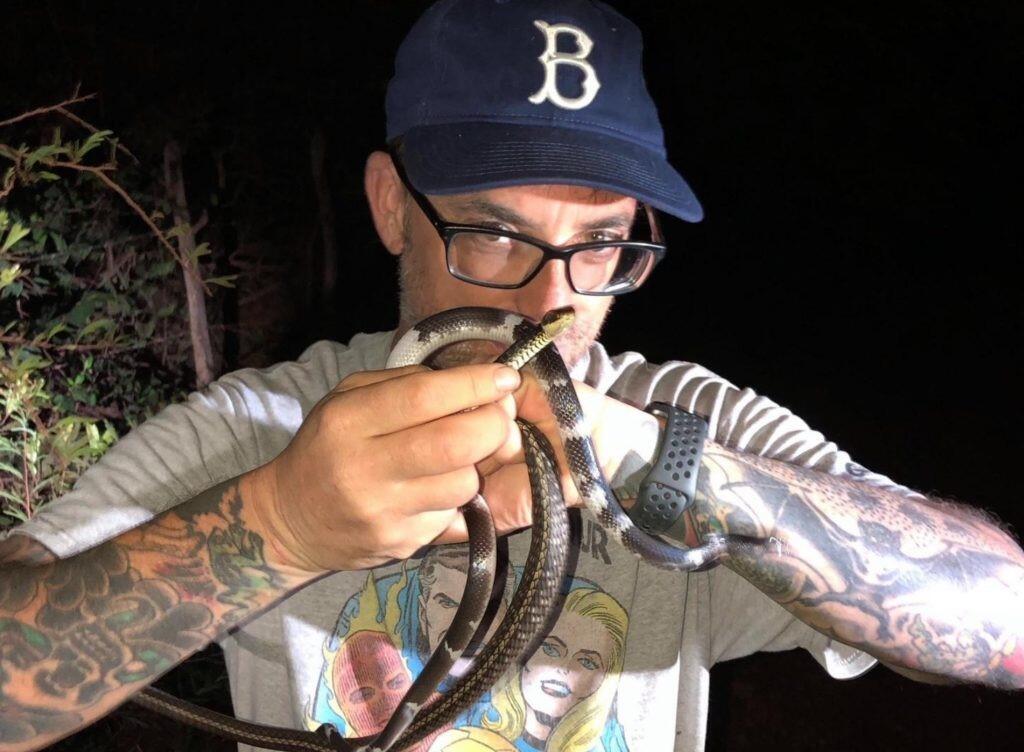Frank T. Burbrink
Curator-in-Charge, Department of Herpetology, Division of Vertebrate Zoology
Principal Investigator, Institute for Comparative Genomics
Professor, Richard Gilder Graduate School

- Email:
- fburbrinkSPAMFILTER@amnh.org
- Phone:
- 212-769-5862
Education
- Louisiana State University, Ph.D., 2000
- University of Illinois (Champaign-Urbana), M.S., 1995
- University of Illinois (Champaign-Urbana), B.S., 1993
Research Interests
Dr. Burbrink examines the evolutionary history and biogeography of reptiles and amphibians across the world. This research helps understand how species are generated, what processes produce patterns of species richness, and how local communities are formed. Within this research framework, he is currently investigating population genetics, phylogeography and systematics of snakes. He has also examined how traits have influenced both species diversification and the regional assemblage of taxa across space and time. Additionally, he also conducts research on divergence dating techniques using integrated molecular phylogenies and fossil data, theoretical phylogenetics, and species tree estimation using genomic data. To collect genomic and morphological data on snakes, he has recently conducted research expeditions with his students across North America, South America, Asia and Madagascar. Finally, to generate realistic models and properly address questions within these major areas of ecology and evolutionary biology, Dr. Burbrink has developed methods to integrate genomic, environmental and morphological data.
Links
Division of Vertebrate Zoology
Richard Gilder Graduate School
Publications
(Recent)
2019
Myers, E.A., R.W. Bryson Jr., R.W. Hansen, M.L. Aardema, D. Lazcano, F.T. Burbrink. 2019. Exploring Chihuahuan Desert diversification in the gray-banded kingsnake, Lampropeltis alterna (Serpentes: Colubridae). Molecular Phylogenetics and Evolution 131:211–218. [DOI 10.1016/j.ympev.2018.10.031]
2018
Burbrink, F.T., and M. Gehara. The Biogeography of Deep Time Phylogenetic Reticulation 2018. Systematic Biology 67(5): 743–755. [DOI: 10.1093/sysbio/syy019]
Lazzeroni, M.E., F.T. Burbrink, N.B. Simmons, 2018. Hibernation in bats (Mammalia: Chiroptera) did not evolve through positive selection of leptin. Ecology and Evolution 8 (24):12576–12596. [DOI 10.1002/ece3.4674]
Oliveira, E.F., M. Gehara, V.A. São-Pedro, G.C. Costa, F.T. Burbrink, G.R. Colli, M.T. Rodrigues, A.A. Garda, 2018. Phylogeography of Muller’s termite frog suggests the vicariant role of the Central Brazilian Plateau. Journal of Biogeography 45: 2508–2519. [DOI 10.1111/jbi.13427]
Oliveira E.F., P.A. Martinez, V.A. São-Pedro., M. Gehara, F.T Burbrink, D.O. Mesquita, A.A. Garda, G.R. Colli, and G.C. Costa. 2018. Climatic suitability, isolation by distance, and river resistance explain genetic variation in a Brazilian whiptail lizard. Heredity 120: 251–265.
Ruane, S., E.A. Myers, K. Lo, S. Yuen, R.S. Welt, M. Juman, I. Futterman, R.A. Nussbaum, G. Schneider, F.T. Burbrink, and C.J. Raxworthy. 2018. Unrecognized species diversity and new insights into colour pattern polymorphism within the widespread Melagasy snake Mimophis (Serpentes, Lamprodiidae). Systematics and Biodiversity 16 (3): 229–244. [DOI 10.1080/14772000.2017.1375046]
2017
Burbrink F.T., J.M.J. Lorch, and K.R. Lips. 2017. Host susceptibility to snake fungal disease is highly dispersed across phylogenetic and functional trait space. Science Advances 3(12):e1701387. [DOI: 10.1126/sciadv.1701387]
Chen, X., A.R. Lemmon, E.M. Lemmon, R.A. Pyron, and F.T. Burbrink. 2017. Using phylogenomics to understand the link between biogeographic origins and regional diversification in ratsnakes. Molecular Phylogenetics and Evolution 111:206–218. [DOI 10.1016/j.ympev.2017.03.017]
Gehara, M., A.A. Garda, F.P. Werneck, E.F. de Oliveira., E.M.S. da Fonseca, F. Camurugi, F.d.M. Magalhães, F.M. Lanna, J.W. Sites, Jr., R. Marques, R. Silveira-Filho, V.A. São Pedro, G.R. Colli, G.C. Costa, and F.T. Burbrink. 2017. Estimating synchronous demographic changes across populations using hABC and its application for a herpetological community from northeastern Brazil. Molecular Ecology 26 (18): 4756–4771. [DOI 10.1111/mec.14239]
Myers E.A., M.J. Hickerson, and F.T. Burbrink. 2017. Asynchronous diversification of snakes in the North American warm deserts. Journal of Biogeography 44 (2):461–474. [DOI 10.1111/jbi.12873]
Teaching Experience
City University of New York:
Biology 70603: Principles of Systemtics (Doctoral course)
Biology 322: Evolution (Undergraduate Course)
Biology 605: Statistics (Master’s Course)
Biology 181: General Biology II: Laboratory (Undergraduate Course)
Biology 79302: Molecular Systematics and Ecology of Vertebrates (Doctoral course)
Biology 272: Biostatistics (Undergraduate Course)
Biology 213: Vertebrate Zoology (Undergraduate Course)
Biology 171: General Biology I: Laboratory (Undergraduate Course)
NESCent:
“Next generation sequencing for phylogenetics and phylogeography” at the National Evolutionary Synthesis Center (NESCent) with Moriarity-Lemmon, Lemmon, Brown, Ané, Bybee and Weisrock.
UFRN in Brazil:
One week of “Coalescent methods for phylogeographic analysis” as part of thephylogeography/population genetics course graduate course in at Universidade Federal do Rio Grande do Norte Centro de Biociências in Brazil.